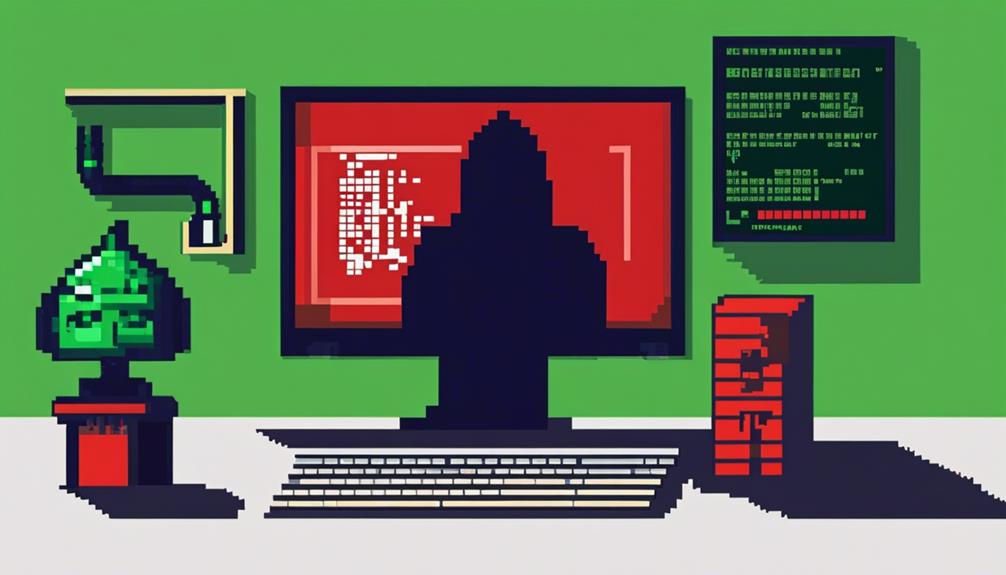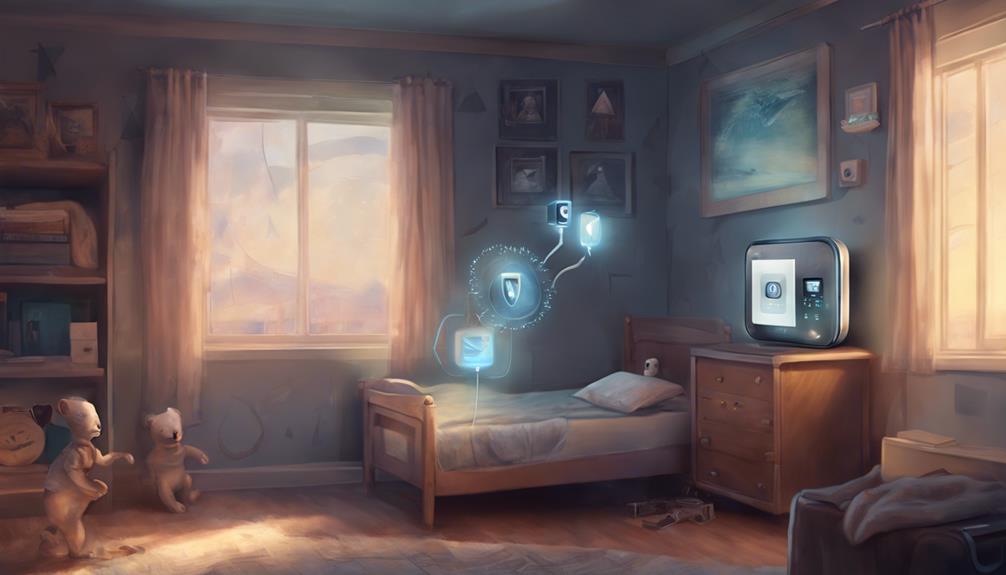To be truly safe from hackers, relying solely on passwords isn't enough. Passwords face rapid cracking speeds with some hackers attempting over 100 trillion guesses per second. Cyber threats evolve, highlighting the need for stronger defenses. Multi-factor authentication and password managers enhance security by adding layers of protection. Educating users on password hygiene is vital to combat social engineering attacks. Safeguarding sensitive information requires diligence in using unique passwords and avoiding reuse. Staying aware of cyber threats and utilizing proactive measures like MFA can prevent breaches. Remember, online security is a continuous journey towards greater protection.
Key Takeaways
- Strong passwords are crucial for safety.
- Use unique, complex passwords for protection.
- Implement multi-factor authentication for added security.
- Regularly update passwords to deter hackers.
- Password managers enhance password hygiene and security.
The Evolution of Password Security
How has password security evolved to meet the increasing challenges posed by cyber threats?
In response to the escalating sophistication of cyber threats, password security measures have undergone significant advancements. One key evolution is the emphasis on using complex passwords that are longer and harder to crack. Instead of relying on simple words or phrases, strong password practices now encourage the use of passphrases that combine multiple words, numbers, and special characters.
Furthermore, the introduction of password managers has revolutionized how individuals secure their accounts. These tools not only generate and store complex passwords securely but also help users manage multiple credentials across various platforms without the need to remember each one.
Password Cracking Speeds Today

Modern password cracking techniques have reached unprecedented speeds, with some rigs capable of performing over 100 trillion password hash guesses per second.
Despite network limitations, average password hackers can still guess NT password hashes at rates exceeding a trillion times per second.
This rapid pace underscores the importance of using complex and unique passwords to thwart attackers exploiting vulnerabilities in systems.
Modern Cracking Techniques
With the ability of some rigs to perform over 100 trillion password hash guesses per second, the rapid speed of modern password cracking techniques is evident. This highlights the critical need for information security and the creation of strong and secure passwords to protect sensitive data.
The average password hacker can iterate through an NT password hash at least a trillion times per second, underlining the importance of robust password protection measures.
It's essential to understand that password guessing is slower than hash cracking due to network constraints and account lockout mechanisms affecting the speed of online attacks. Offline password hash cracking is typically faster than online guessing, emphasizing the necessity for strong password defenses to thwart unauthorized access attempts.
Cybercriminals often employ dictionary words and numbers in their cracking strategies, underscoring the significance of crafting unique and complex passwords to deter hackers effectively.
Importance of Complexity
Ensuring password complexity is paramount in today's cybersecurity landscape, given the rapid speed at which hackers can crack passwords using advanced tools and techniques. Hackers can perform over 100 trillion password hash guesses per second, showcasing their ability to break into systems swiftly. This highlights the critical need for strong and complex passwords to thwart malicious actors.
Average password hackers can attempt a trillion guesses per second on NT password hashes, emphasizing the importance of robust security measures like multifactor authentication (MFA) to enhance protection.
While password guessing may be slower due to network limitations and account lockouts, offline attacks can crack 18-character human-created passwords with common patterns. This underscores the necessity for users to opt for unique, random, and lengthy passwords to safeguard their accounts effectively.
Password hash cracking speed is notably accelerated offline, underscoring the importance of stringent password policies to mitigate cybersecurity risks.
Vulnerabilities in Systems
Given the exponential increase in password cracking speeds by hackers, the vulnerability of systems to unauthorized access continues to escalate in today's cybersecurity landscape.
Some rigs can perform over 100 trillion password hash guesses per second, illustrating the rapid pace of modern password cracking capabilities. On average, hackers can attempt to guess an NT password hash at least a trillion times per second, showcasing the efficiency of hacking attempts.
However, online password guessing attacks can be hindered by factors like network limitations and account lockout mechanisms, which slow down the process. Attackers often rely on stolen password dump lists to crack longer passwords easily, underscoring the importance of using strong, unique passwords to enhance security.
As individuals tend to have multiple accounts across various platforms, ensuring the strength of passwords is vital in safeguarding sensitive information and preventing unauthorized access.
Quantum Computing Threats

The emergence of quantum computing poses a critical threat to traditional password security measures. Quantum computers have the potential to crack any password in a matter of minutes, rendering current protection methods ineffective.
This looming threat highlights the necessity of enhancing security practices. Users should consider implementing multifactor authentication (MFA) and password managers to bolster their defenses against quantum cracking.
The future reality of quantum threats underscores the importance of adopting secure practices, such as using unique and random passwords for every account. The advancements in quantum computing could soon outpace the capabilities of traditional password security measures, urging individuals and organizations to prepare for more advanced security protocols.
As quantum cracking becomes a more imminent threat, users must stay informed and proactive in safeguarding their sensitive information against this powerful technology.
Importance of Strong Passwords

Strong passwords are essential in protecting sensitive information from cyber threats.
The complexity and length of passwords play a critical role in preventing unauthorized access.
Password Security Basics
Effective password security is paramount in safeguarding your online accounts from potential cyber threats. To enhance your password security basics, consider the following:
- Avoid Password Reuse: Over 60% of individuals use the same password for multiple websites, increasing vulnerability to hacking.
- Risk of Compromise: 1 in 5 Americans experience the compromise of online accounts due to weak passwords, highlighting the importance of strong security measures.
- Perception vs. Reality: Despite the risks, 89% of users feel their password habits are adequate, indicating a need for better understanding of cybersecurity threats.
- Generational Differences: Individuals aged 50-64 are less likely to reuse old passwords, showcasing a generational gap in password security awareness, with digital natives (18-24) being the most prone to reusing passwords.
Password Best Practices
Emphasizing the significance of robust password practices is fundamental in fortifying online security measures against potential cyber threats. Using the same password for multiple websites, as admitted by over 60% of people, significantly increases vulnerability to hacking attempts. Having more than ten password-protected accounts, a habit found in 70% of users, underscores the importance of strong and unique passwords. Utilizing a secure password manager, as done by almost 30% of individuals, is one of the best ways to protect your accounts. Prioritizing the use of complex passwords or passphrases, a practice followed by 56% of users, is crucial for enhancing online security. Moreover, the trend of people aged 25-34 leading in using complex passwords indicates a growing awareness of password security practices.
| Best Ways to Protect | Statistics |
|---|---|
| Use unique passwords | 70% of users have more than ten accounts |
| Utilize a password manager | Almost 30% use a secure password manager |
| Prioritize complexity | 56% of users use complex passwords or passphrases |
| Avoid using same password | Over 60% admit to using the same password multiple times |
| Stay vigilant | People aged 25-34 lead in using complex passwords |
Multi-Factor Authentication Benefits

Multi-factor authentication offers a crucial additional layer of security for safeguarding online accounts against unauthorized access. Here are some benefits of implementing multi-factor authentication:
- Enhanced Security: MFA adds an extra step beyond passwords, making it harder for hackers to gain access to sensitive personal data.
- Additional Verification: Users must provide a third form of verification, such as a code from a separate device, increasing account security.
- Risk Reduction: Even if passwords are compromised, MFA notably reduces the risk of unauthorized access to accounts.
- Protection Against Threats: By requiring multiple factors for authentication, MFA effectively enhances protection against breaches and cyber threats.
In light of these advantages, users are strongly encouraged to enable multi-factor authentication to fortify the security of their online accounts and safeguard their sensitive information effectively.
Role of Password Managers

Password managers play an important role in securely storing and managing all passwords in one encrypted location. These tools are essential for safeguarding personal information and login credentials.
About 28% of users currently utilize password managers to enhance their password security. By using password managers, individuals can generate and store complex, unique passwords for each of their accounts, reducing the risk of unauthorized access. It is important to maintain a strong master password for the manager to guarantee the security of all stored passwords.
Despite their benefits, cybercriminals often target password managers due to the concentration of valuable login information they hold. Hence, it is crucial for users to remain vigilant and take necessary precautions to protect their password manager with robust security measures.
Educating Users on Password Hygiene

To enhance online security practices, educating users on proper password hygiene is paramount in today's digital landscape. Understanding the risks associated with poor password habits is vital.
Here are four key points to keep in mind:
- Social Engineering Awareness: Educate users on the tactics used by hackers to trick individuals into revealing passwords. Being vigilant against such tactics can greatly enhance online security.
- Importance of Unique Passwords: Encourage the use of different passwords for each online account. This practice prevents a single password compromise from affecting multiple accounts.
- Password Manager Benefits: Highlight the advantages of using password managers to store and generate secure passwords. This can alleviate the burden of remembering multiple complex passwords.
- Regular Password Updates: Emphasize the importance of regularly changing passwords to mitigate the risks associated with potential breaches. This practice enhances overall online security posture.
Safeguarding Sensitive Information

In the domain of online security, safeguarding sensitive information is an essential measure to counter the prevalent risks associated with poor password practices. Reusing the same password for multiple accounts is a common but risky habit, as over 60% of people admit to doing so, increasing vulnerability to hacking attempts. Shockingly, 1 in 5 Americans have experienced compromises due to this practice, showcasing the seriousness of the issue.
To make sure sensitive information remains secure, it is vital to avoid using the same password across different accounts. Password breaches can lead to severe consequences, highlighting the need to prioritize security over convenience. Nearly 40% of users resort to writing down passwords, which emphasizes the challenge of managing multiple accounts securely.
Implementing multi-factor authentication and steering clear of password reuse are critical steps in fortifying the protection of sensitive information. By adopting these practices, individuals can greatly enhance their online security posture and reduce the risk of falling victim to cyber threats.
Cyber Threats and Password Protection

Protecting sensitive data online requires a proactive approach to counter the growing threats posed by cybercriminals.
To enhance password protection and mitigate cyber threats, consider the following:
- Password Managers: Utilizing password managers can help generate and store complex, unique passwords for each online account, reducing the risk of password guessing.
- Avoid Password Reuse: Users often reuse passwords across multiple websites, making it easier for attackers to gain unauthorized access. Using unique passwords for each account is essential for enhanced security.
- Beware of Patterns: Attackers often leverage old passwords and common patterns for password guessing attacks. Avoid using easily guessable information such as birthdays or common phrases.
- Multi-Factor Authentication (MFA): Implementing MFA adds an extra layer of security beyond passwords, making it harder for cybercriminals to access accounts even if passwords are compromised.
Frequently Asked Questions
What Is the Most Common Hacked Password?
The most common hacked password is '123456,' followed by 'password' and '123456789.' Hackers frequently target easily guessable passwords like 'qwerty' and exploit users who reuse passwords, increasing the risk of successful hacking attempts.
What Can a Hacker Do With My Password?
A hacker with your password can gain unauthorized access to your accounts, potentially leading to identity theft, fraud, and spreading malware through malicious messages. Your compromised password may also be sold on the dark web, exposing you to further security risks.
What Method Would a Hacker Use to Break a Password?
A hacker may employ various methods to break a password, including brute force attacks, dictionary attacks, and rainbow table attacks. These techniques aim to systematically guess or crack passwords to gain unauthorized access to systems or accounts.
Can Hackers Crack Your Password?
Hackers can crack passwords through various means, such as dictionary attacks and brute force methods. Their ability to guess trillions of times per second, combined with offline hash cracking capabilities, poses a significant threat to password security.
Conclusion
In the digital world, passwords are like the keys to a fortress, safeguarding our most valuable information from malicious intruders.
With the rise of advanced hacking techniques and the looming threat of quantum computing, it is more crucial than ever to prioritize strong password security measures like multi-factor authentication and password managers.
By educating ourselves on proper password hygiene and staying vigilant against cyber threats, we can guarantee our data remains safe and secure in the face of evolving technological challenges.









